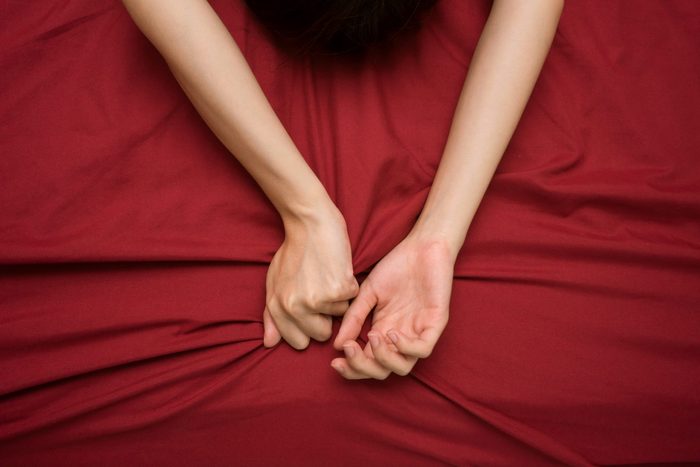Are There Different Types of Orgasms? What Sex Experts Say

Some sexual health experts say yes, there are at least nine different types of orgasms, others ask "does it really matter?"
Oh, those orgasms! Known as “le petit mort” or “the little death” in French, an orgasm is that pleasurable release that people experience, usually as a result of sexual stimulation.
What really happens to your brain when you have sex, and if you have an orgasm? In short, the brain releases tons of feel-good chemicals. While there are many different ways to experience pleasure, according to some experts there may be more than one type—in fact many more—of orgasm. However, not all experts agree.
Here’s what you need to know about different types of orgasms.
(Related: I Can’t Seem to Orgasm During Sex. What Gives?)
Are there different types of orgasms?
The answer depends on who you ask. Psychologist Laurie Mintz, a psychology professor at the University of Florida, says that experts typically fall into a couple (or more) different camps when talking about orgasms in people who have vaginas. One group believes that there are at least two different types—clitoral and vaginal or G-spot orgasms.
Mintz explains that those two pathways, the vagina and the clitoris, are thought of as analogous to orgasms in men through stimulation of the penis and prostate. “Women say they feel different,” says Mintz, author of Becoming Cliterate.
The experts who believe there are different types of orgasms often point to research in the journal Spinal Cord Injury Rehabilitation on women who’ve had spinal cord injuries. The research found that women were able to learn to orgasm through different types of stimulation, according to Mintz. It’s likely because the clitoris is connected to the spinal cord and the brain via different neural pathways than the vagina, Mintz says.
Other experts believe that, no matter where the stimulation, all orgasms involve the clitoris because it is a vast organ with both internal and external components. Those experts would prefer that people stop saying there are separate types of orgasms in people with vaginas because every orgasm basically involves the clitoris and brain, according to Mintz.
(Related: An Expert Shares How to Have Good Sex)
Is this the wrong question to ask?
Another group believes that this question is off-base. Why break down what is one functional unit—female genitals—into different little pieces? Some believe the entire genital area should be called a clitoris because, again, it’s the biggest sex organ in people with vaginas, according to Mintz. If fact, it’s not clear why people put so much emphasis on this question. “By doing so we are creating a false hierarchy of one orgasm type better than the other,” Mintz says.
When people label orgasms, it’s usually based on the point of stimulation. But Mintz points out that orgasms are all the same physiologically. “It’s an increase in blood flow to the erectile tissue and then the pelvic floor muscles rhythmically contracting and releasing the blood,” Mintz says.
There’s evidence to back this up. In a study published in the Archives of Sexual Behavior, researchers collected 48 descriptions of orgasms, half from men and half from women. After removing all details that gave a clue to sexual orientation or anatomy, they presented the descriptions to a group of OB-GYNs, sex therapists, and medical students.
“Most people talked about a great build-up of tension and a great release,” she says. None of the experts could correctly identify the sex of the person describing an orgasm. “There was no way to differentiate them,” Mintz says. What’s more, people don’t typically label men’s orgasms by the point of stimulation. “We don’t ask if a blow job orgasm is better than an intercourse orgasm,” Mintz says.
If we don’t do that with men, why are we doing this with women? Psychoanalyst Paul Joannides, author of The Guide To Getting It On, agrees that the idea is misleading. “Rather than talking about the different kinds of orgasms as if there was some sort of list with checkboxes that was sent down by Mother Nature, we should be encouraging women to explore and find some of the different combinations of stimulation that work best for them,” he says.
(Related: Condoms Have Just Gotten a Very Necessary Makeover)
The types of stimulation that lead to orgasm
Leah S. Millheiser, MD, OB-GYN, a female sexual medicine expert and faculty at Stanford University, says that different types of stimulation could cause people with vaginas to orgasm. Clinical sexologist Joe Kort, director of The Center for Relationship and Sexual Health in Royal Oak, Michigan, agrees, listing the following points.
(Related: 49 Interesting Sex Facts You Probably Didn’t Know)
Clitoral
“This type of orgasm is the most intense because the clitoris is packed with more than 8,000 nerve endings,” Kort says. Rubbing up and down, back and forth, or in a circular motion may bring pleasure. Some people may enjoy stimulating this area with a vibrator or sex toy, according to Kort.
G-spot or vaginal
You can stimulate or gently massage the front wall of the vagina (the G-spot) by inserting fingers, a penis, or a vibrator into the vagina and pressing forward on the anterior wall, according to Kort.
“Find the touch that feels good for you,” he says.
Nipple
Nipples are major erogenous zones. “They have a concentrated area of nerve endings that, when stimulated, send a signal to activate the pleasure centre of the brain,” Kort says.
A-spot or cervical
Similar to the G-spot, the A-spot is on the anterior wall of the vaginal canal, but closer to the cervix, according to Kort. Speaking of the cervix, Dr. Millheiser says some women will have cervical orgasms because deep penetration stimulates the cervix. “We know that’s real because there are many women after hysterectomies who say they are no longer able to have enjoyable orgasms because their cervix is no long there,” Dr. Millheiser says.
Anal
“There are a lot of unexplored nerve endings in the anal area that can result in explosive orgasms,” Kort says. “Stimulate the anus by rubbing the outside of the anal opening and using a lubricated finger to probe gently and penetrate the anal canal.” Kort says this type of sex does come with risks, so make sure you practice safer sex when trying anal sex.
Blended
Stimulate two, three, or more erogenous zones at once for a blended orgasm. “You can do this with a partner or solo,” Kort says. “The more stimulation, the more blood flow and the bigger the orgasm.”
Corecasm
Believe it or not, you can experience a workout-induced orgasm, or coregasm, which is intense exercise of the muscles around the core that can trigger contractions in the pelvic floor leading to an orgasm, according to Kort.
Sleep orgasm
“While sleeping, your body is relaxed, muscles are more relaxed, and your breathing is deeper, which allows the body to become more easily aroused,” Kort says. “A sensual dream can cause increased blood flow to the genitals, allowing the body to reach orgasm while you are asleep.”
Thinkgasm
You can think your way to an orgasm through your own sexual fantasy, too.
Types of male orgasms
Men typically have an orgasm through penile or prostate stimulation, but Kort says it is possible for men also to have a pelvic or blended orgasm. “Through practice, men can learn to hold their orgasm and send energy rushing back into their pelvic region for greater, longer, and more intense sexual satisfaction,” Kort says. “You need to focus and relax your mind while controlling your bodily functions to hold back ejaculation, which sends your body into a full pelvic orgasm.”
(Related: 5 Myths About Your Lady Parts–Debunked)
Reasons why orgasm intensity varies
So many things impact the ability to orgasm (with or without a partner). And even more variables play a part in how intense the orgasm feels. “It’s really a mix of subjective factors and physical factors,” Dr. Millheiser says. Orgasms (unfortunately) aren’t always as simple as stimulation and release.
(Related: The Honest, Expert-Backed Truth About Having Sex While on Your Period)
Your hormones
Orgasm intensity is partly based on your hormonal profile. “So if you’re a post-menopausal woman, you may experience a less intense orgasm because you have decreased blood flow to the genitals and decreased nerve sensation,” Dr. Millheiser says. “Women after menopause may experience less intense orgasms, it may take them longer to achieve orgasm, and that’s due to hormonal changes.”
However, some orgasms will simply be stronger than others for a variety of factors; it may be less intense one day, and it may be more another. It doesn’t necessarily mean anything, Dr. Millheiser says, and there’s not always a clear explanation as to why some orgasms are stronger than others.
(Related: Can Hormone Therapy Ease Your Menopause Symptoms?)
Mental arousal
The type and intensity of the fantasy a person is having can make a big difference in how an orgasm might feel, according to Joannides. “Brain studies have shown that when a woman is having a strong sexual fantasy while not touching her genitals, the same parts of her brain light up with the same amount of intensity as when she is masturbating,” he says. “So we might assume that the right fantasy can help to greatly amplify the data that’s coming from between her legs and from other parts of her body.”
Dr. Millheiser adds that people with vaginas generally say that if there’s mental arousal and the physical stimulation goes on for a while, they build-up to the orgasmic platform. “So you’re going to have a stronger muscle contraction and possibly a more intense experience,” she says.
(Related: Can Cannabis Help Kick-Start My Sex Drive?)
Relationship status
“We know that relationship satisfaction can play a huge role in whether a woman has orgasms and how satisfying she says they are,” Joannides says. “We also know that women tend to report the orgasms they have with a partner are more satisfying than the orgasms they have when they are masturbating.”
So if you want to know about different types of orgasms, Joannides suggests distinguishing between “alone-orgasms” and “partner-orgasms.”
(Related: 16 Sex Problems Marriage Counsellors Hear About All the Time)
Outside factors, like time
“You may have a not so intense orgasm one day because you’re in a hurry and things are going fast, and maybe you don’t get yourself as aroused,” Dr. Millheiser says. “Again, the amount of blood flow that you have going to the genitals determines your intensity of orgasm, so if you’re just looking for a quickie, you may not have as intense of orgasm vs. if it’s something more slow and built up over time.” So it may be less intense one day, and it may be more another, so it doesn’t really necessarily mean anything.
(Related: 3 Ways Your Sex Life May Change at Midlife)
Solo vs. partnered
Dr. Millheiser says women tell her they often have intense orgasms during masturbation, but not with a partner. She says that may be because, when with a partner, there’s less mindfulness typically happening. You may be focused on what your partner is thinking, wondering if you’re taking too long, or thinking about how you look, according to Dr. Mihheiser
“All these things that go through a woman’s head and take her away from the mindful moment and being able to really get into the moment,” she says. “Sometimes we self-sabotage during sexual activity because of not being mindful, and that may lead to not experiencing as intense of an orgasm or maybe not experiencing an orgasm at all.”
Of course, you might not be having orgasms with a partner because they are not stimulating you in the right way or for long enough to achieve orgasm. In that case, better communication and experimentation may help.
(Related: How to Increase Your Libido — And Why It May Be Low)
Other things to know about orgasm types
If it isn’t broken, don’t feel pressure to “fix” it
Someone recently asked Mintz, “I always orgasm the same way, what do I do?” Her response is another question: why would you want to do anything? “Are you satisfied or bored?” Mintz asks. “Where is this desire coming from?” If it is boredom, Mintz approves of experimentation.
“If it’s because you’re bored and you want to experiment, terrific, do it. I’m all about that [and] a lot of times sex routines get boring, and they need to be mixed up a bit,” she says. But if you’re doing it because you think there’s a better way out there, know that you’re not necessarily missing out. She typically gets this question specifically about using vibrators, too. Again, if you do have orgasms with a vibrator, there’s nothing wrong with that fact. “Do we tell men, ‘Oh my gosh you always come from intercourse?’ or ‘Don’t you think you should try to find a different way?'”
(Related: 13 Sex Problems You Should Take Seriously)
Most women need clitoral stimulation to orgasm
Although there are a lot of different types of stimulation that can cause orgasms, not all people with vaginas can achieve more than one type, according to Dr. Millheiser. And there are certainly people who have difficulty achieving any type. “For most women, they’ll say there’s one way or maybe two ways that [they’re] able to achieve orgasm, and for some lucky women, there’s more than that,” Dr. Millheiser says.
She says the status quo is that most women have clitoral orgasms. “We know most nerves are in the clitoris,” Dr. Millheiser says. “Yes, you may have different types of orgasms or more intense orgasms with dual stimulation in different areas, but the majority of women will say reliably that it is clitoral stimulation that brings them to orgasm.”
Only about 18 percent of women said they could have an orgasm with vaginal intercourse alone, and 37 percent said they needed clitoral stimulation, according to a 2018 survey of over 1,000 women published in the Journal of Sex & Marital Therapy. A 2015 survey found that 14 percent of women under 35 had never had an orgasm from intercourse, according to a report in Socioaffective Neuroscience & Psychology.
(Related: 14 Ways to Enjoy Better Sex as You Age)
Experimentation
Although most people at a certain point can identify what feels good to them, Dr. Millheiser suggests people do this if they haven’t already. “First things first, you need to know what feels good for you, and you need to know how you achieve orgasm and then share that with your partner,” she says. “You might also find through exploration with a partner that you do, for example, have nipple induced orgasms, and neck or behind the ear induced orgasms.” It comes down to exploring your body by yourself and with a partner, if you want to improve your sex life.
(Related: 9 Things That Happen to Your Body If You Stop Having Sex)
Bottom line
It is possible to orgasm from many different types of stimulation. But one type of stimulation is not necessarily better than another. And there’s nothing wrong with needing certain types of stimulation to reach orgasm. Many experts believe that categorizing types of orgasms is the wrong approach to this topic. What they all agree on, however, is that exploration on your own terms and for your own pleasure is always a good idea. Just don’t expect one orgasm to be necessarily superior.
Mintz sums it up with a quote from Betty Dodson, an orgasm guru and coach. “‘An orgasm is an orgasm is an orgasm.’ In other words, it’s an orgasm, period,” Mintz says. “Wherever you’re getting it from, it’s an orgasm. None are better than others.”
Next: 8 Habits of Connected Couples for Better Sex and More Intimacy




